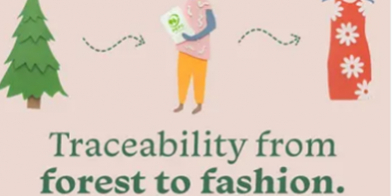As featured by PEFC International
Who wins the sustainability argument: the cotton shirt or the polyester shirt? Unfortunately, there is no simple way to call the winner.
Choosing sustainable materials is one big positive step businesses – and consumers – can take towards climate action.
In an important webinar organised this month by the Textile and Fashion Federation (TaFF) Singapore, industry experts spoke about the sustainable material trends and what lies ahead. What are the preferred materials and why it makes a difference?
PEFC was represented in the webinar by Deepa Hingorani, who has 20 year’s experience within the fashion industry. She explained to the online audience that PEFC chain of custody is a mechanism to trace certified material from sustainable forests to the finished product.
By eliminating raw materials linked to deforestation, biodiversity loss, exploitation of endangered species, as well as human rights and labour rights, fashion brands can use PEFC-certified materials to demonstrate their commitment to sustainability and win consumer support in the process.
There is a definite move, Ms Hingorani insists, towards greater use of Man-made cellulosic fibres (MMCF), such as Viscose/Rayon, Lyocell, Modal, and Cupro, as these form the second biggest cellulosic fibre group after cotton.
The MMCF value chain has the potential to tackle some of the apparel and broader textile industry’s most significant sustainability challenges and, consequently, make a very real contribution to building resilience and accelerating regeneration.
She also pointed out in her presentation that PEFC-certified MMCF has been included in the global Fashion Pact’s list of materials considered to have lower impact on the environment.
“This means that 60-plus leading fashion brands, who signed the Fashion Pact, can now use PEFC-certified materials to advance on their collective climate target: transition 25% of their key materials to lower climate impact sources by 2025.”
Ms Hingorani drew attention to our white paper ‘Fashions Change, Forests Stay’, which sets out how sustainably managed forests, and the shift towards responsibly sourced and certified forest-derived products, plays a vital role in helping fashion brands and retailers meet their commitments to tackling climate change.
PEFC can help manufacturers and retailers move to a more sustainable future, increasing business resilience and meeting their climate goals.
“We are already working with fashion brands and retailers,” Ms Hingorani pointed out, “by helping them maximise their impact through sustainable forest management.”
She mentioned the PEFC brand collaboration with Salvatore Ferragamo, as well as working on brand procurement policies with many others, including Karl Lagerfeld, Guess, River Island, and Farfetch.
The webinar organised by TaFF is in the Industry Insights series and part of the organisation’s sustainability programme, which was launched in November 2021. We announced at the same time a new partnership agreement with TaFF in Singapore and Southeast Asia. The three-year strategic roadmap aims to help TaFF promote fashion supply chain sustainability and responsible procurement.
Responsible Wood is the National Governing Body for PEFC in Australia. To find out more about Responsible Wood and forest certification more generally please visit the Responsible Wood website.







